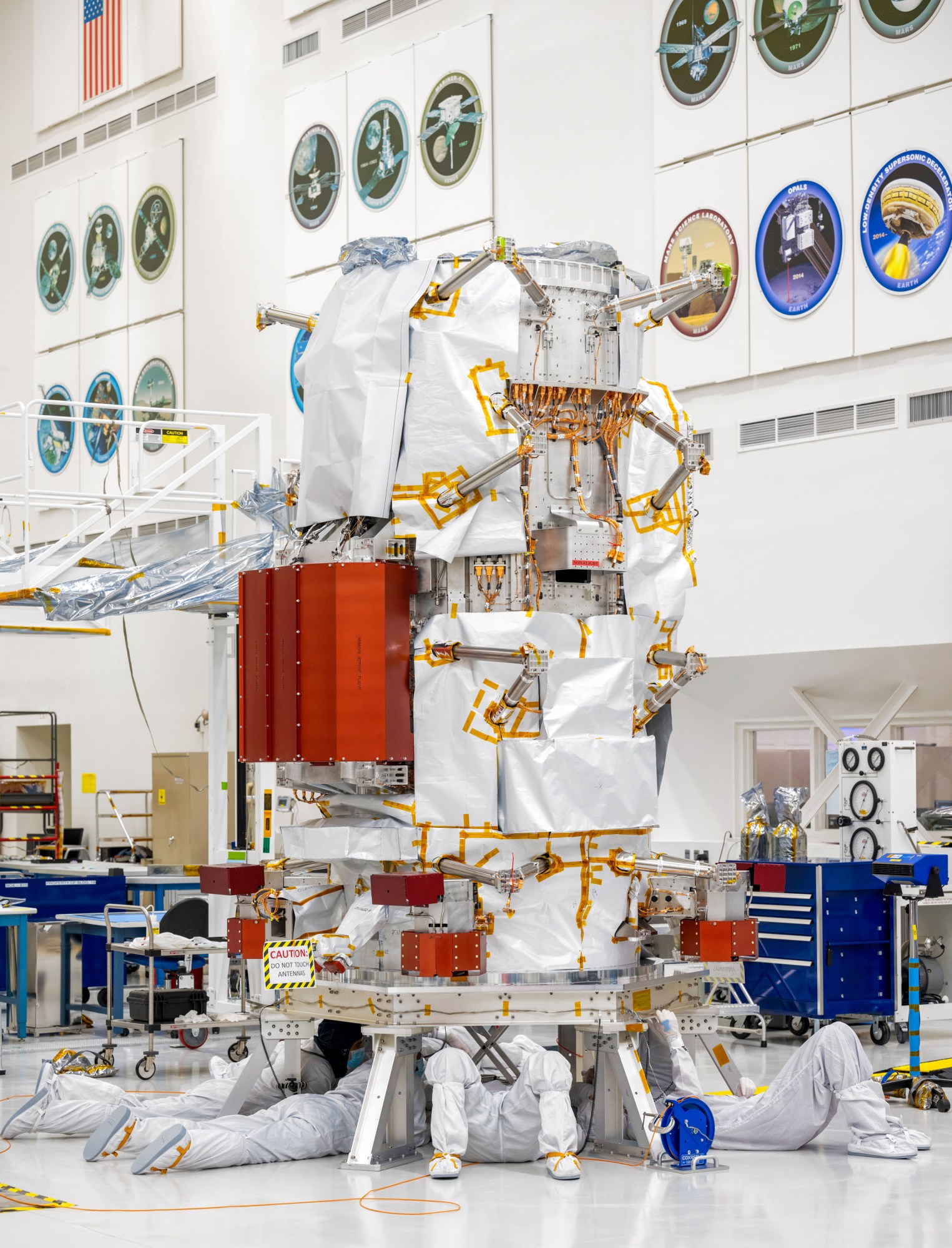
We’ve known of Europa’s existence for more than four centuries, but for most of that time, Jupiter’s fourth-largest moon was just a pinprick of light in our telescopes—a bright and curious companion to the solar system’s resident giant. Over the last few decades, however, as astronomers have scrutinized it through telescopes and six spacecraft have flown nearby, a new picture has come into focus. Europa is nothing like our moon.
Observations suggest that its heart is a ball of metal and rock, surrounded by a vast saltwater ocean that contains more than twice as much water as is found on Earth. That massive sea is encased in a smooth but fractured blanket of cracked ice, one that seems to occasionally break open and spew watery plumes into the moon’s thin atmosphere.
For these reasons, Europa has captivated planetary scientists interested in the geophysics of alien worlds. All that water and energy—and hints of elements essential for building organic molecules —point to another extraordinary possibility. In the depths of its ocean, or perhaps crowded in subsurface lakes or below icy surface vents, Jupiter’s big, bright moon could host life.
“We think there’s an ocean there, everywhere,” says Bob Pappalardo, a planetary scientist at NASA’s Jet Propulsion Laboratory in Pasadena, California. “Essentially everywhere on Earth that there’s water, there’s life. Could there be life on Europa?”
Pappalardo has been at the forefront of efforts to send a craft to Europa for more than two decades. Now his hope is finally coming to fruition: later this year, NASA plans to launch Europa Clipper, the largest-ever craft designed to visit another planet. The $5 billion mission, scheduled to reach Jupiter in 2030, will spend four years analyzing this moon to determine whether it could support life. It will be joined after two years by the European Space Agency’s Juice, which launched last year and is similarly designed to look for habitable conditions, not only on Europa but also on other mysterious Jovian moons.
Neither mission will beam back a definitive answer to the question of extraterrestrial life. “Unless we get really lucky, we’re not going to be able to tell if there is life there, but we can find out if all the conditions are right for life,” says planetary geologist Louise Prockter at the Johns Hopkins Applied Physics Laboratory, a co-investigator on the Clipper camera team.
“Essentially everywhere on Earth that there’s water, there’s life. Could there be life on Europa?”
Bob Pappalardo, planetary scientist, NASA’s Jet Propulsion Laboratory
What these spacecraft will do is get us closer than ever before to answers, by identifying the telltale chemical, physical, and geological signatures of habitability—whether a place is a suitable environment for life to emerge and thrive.
The payoff for confirming these signs on Europa would be huge. Not because humans could settle on its surface—it’s far too harsh and rugged and cold and irradiated for our delicate bodies—but because it could justify future exploration to land there and look for alien life-forms. Finding something, anything, living on Europa would offer strong evidence for an alternate path through which life could emerge. It would mean that life on Earth is not exceptional. We’d know that we have neighbors close by—even if they’re microbial, which would be the most likely life-form—and that would make it very likely that we have neighbors elsewhere in the cosmos.

“With the prospects of life—the prospects of vast oceans—within reach, you just have to go,” says Nicholas Makris, director of MIT’s Center for Ocean Engineering, who uses acoustics and other innovative methods to observe and explore big bodies of water. He once led a team of scientists who proposed a mission to land a spacecraft on Europa and use sound waves to explore what lies beneath the ice; he still hopes to see a lander go there one day. “You have to find out. Everyone wants to know,” he says. “There isn’t anyone who doesn’t want to know.”
From a spot in the sky to a dynamic moon
Long before it became the cosmic destination of the year, Europa played an outsize role in transforming our understanding of the solar system. That began with its discovery, when one night in January 1610, the Italian astronomer Galileo Galilei fixed his occiale—an ingenious homemade telescope—on Jupiter and noted three bright little dots near the side of the gas giant.
Galileo assumed it was an illusion, that they were distant stars that only appeared to be close. But the next night, he observed those same three bright little stars now on the other side of the planet. Further observations revealed yet another bright light, also wandering nearby but refusing to leave Jupiter’s side. In a short treatise called Sidereus Nuncius (Starry Messenger), published in March 1610, Galileo reported that he’d found four worlds orbiting Jupiter, similar to how Mercury and Venus orbit the sun. (Astronomers still regard Jupiter and its satellites as a kind of mini solar system.) Galileo named the worlds I, II, III, etc., and referred to them as the “Medicean planets,” though they’re now called the “Galilean moons.” His discovery was the first time scientists had directly observed small worlds orbiting something other than Earth or the sun, giving strong evidence to the argument, still controversial at the time, that planets circled the sun and not the other way around.

Naming rights for these four Jovian moons ultimately went to the German astronomer Simon Marius, who claimed (but couldn’t prove) that he’d actually discovered them a few weeks before Galileo. In 1614, on a suggestion from Johannes Kepler, Marius proposed naming the moons Io, Callisto, Europa, and Ganymede—after four “irregular loves” pursued by Zeus (Jupiter) in ancient mythology. It took 200 years for those names to gain widespread adoption, but they were definitely an upgrade. Had Galileo’s naming scheme stuck, you’d now be reading about the “II Clipper,” which doesn’t have the same ring.
These moons were only the first to be discovered orbiting Jupiter. As of December 2023, astronomers had officially confirmed the existence of 91 others—and there are likely many more. Where the first four are round and follow stately, simple orbits, the more recent discoveries are more diverse. Some orbit in erratic swarms or go the opposite way around; some were asteroids captured in passing; others resulted from collisions. There are so many objects around Jupiter, in fact, that the International Astronomical Union no longer confers names on Jovian satellites unless they’re deemed to have significant scientific value.
The more we’ve learned about Europa, the more fascinating it has become. For centuries, it was little more than a spot appearing to move from one side of Jupiter to the other. But by the early 20th century, stargazers had made reasonable estimates of Europa’s diameter and mass (revealing that it was slightly smaller than Mercury or Earth’s moon, but larger than Pluto). They’d also studied the light reflecting from its surface and found that Europa was unexpectedly bright. Were it to replace our moon in the night sky, Europa would be a little smaller but shine five times brighter.
In the 1950s, when scientists began regarding distant objects not as bright cosmic curiosities but as real worlds, each with a distinct origin story, they began to ask questions about composition and formation. In The Planets, a book published in 1952, the astronomer Harold Urey suggested that water ice was abundant in the outer solar system because the bodies there formed far from the sun and never became warm enough for their ice to evaporate. By the 1960s, astronomers and astrophysicists had begun to speculate, partly on the basis of early measurements of its infrared spectrum, that Europa’s extraordinary reflectance was indeed due to the presence of ice. But proving it was difficult.
Stephen Ridgway, now an astronomer at the National Science Foundation’s NOIRLab in Tucson, Arizona, first heard about the problem of potentially icy moons in the outer solar system in the early 1970s, as a graduate student. Carl Pilcher, a postdoctoral researcher he’d met at a conference, told him about it. “We think they should have ice on them because they’re cold and reflective, but is it water? Is it carbon dioxide ice? Is it some other kind, or some mixture?” Ridgway recalls him asking.
It turned out that Ridgway, who describes himself as a tinkerer as well as a physicist, was well positioned to answer those questions. Using an old mathematical trick, he had devised an innovative instrument that could capture the spectrum of a distant light source, and he was using it during nighttime observations at a telescope at Kitt Peak Observatory, in Arizona. Every element and molecule absorbs and emits a unique collection of wavelengths of energy, and astronomers can read these spectra as fingerprints that reveal the composition of cosmic bodies. Pilcher suggested that he use the instrument to observe Europa.
They thought it would take a week to get a useful spectrum of one of Jupiter’s moons. “I went and got it in one night, maybe two,” Ridgway recalls. Ridgway showed the data to Pilcher, who showed it to his advisor, Tom McCord. Their analyses, published in Science in December 1972, suggested that water ice covered at least half, and possibly all, of the surface of Europa. (They also confirmed that the Jovian moons Ganymede and Callisto, both of which are larger than Europa, also had ice on their surfaces.)
In a 1980 paper, scientists reported that Europa looked “cracked like a broken eggshell” and compared it to a white pool ball fouled by a felt-tip pen.
One year later, the Pioneer 10 spacecraft, which had launched in March 1972, passed close enough to Europa to take a photo. The grainy image was provocative enough to justify sending Pioneer 11—which launched in 1973—to swing by on its way to Saturn and then out of the solar system.
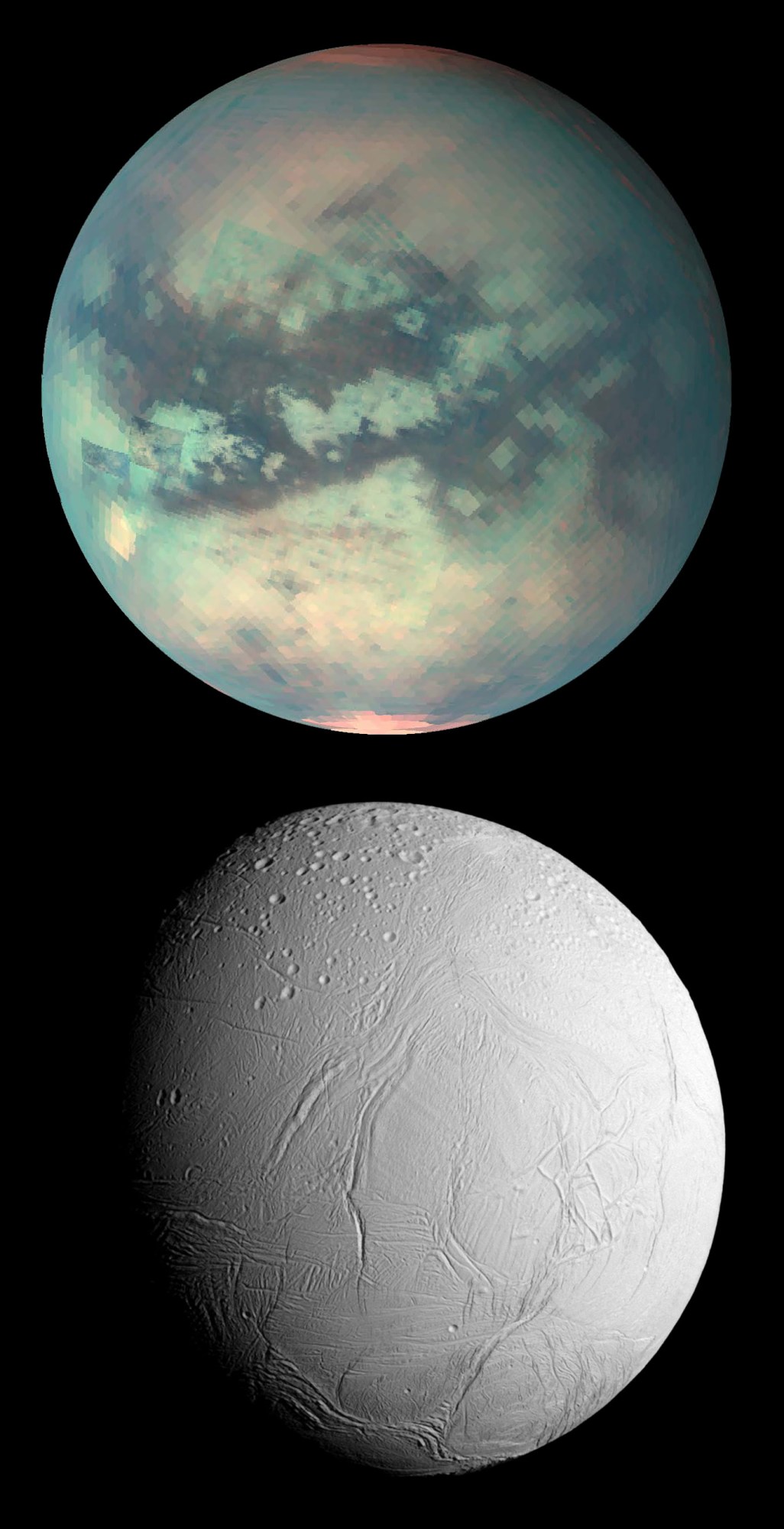
But Europa really started to come into focus in 1979, after the Voyager 2 spacecraft sped past the moon on July 9. (Voyager 1 also passed near Europa, but Voyager 2 had better photos.) The photographs the spacecraft beamed back revealed a smooth, bright surface, crisscrossed by long linear marks and low ridges; they might have been cracks or cliffs. In a 1980 NASA paper describing the observation, scientists reported that Europa looked “cracked like a broken eggshell” and compared it to a white pool ball fouled by a felt-tip pen. A 1983 Nature paper fueled interest in Europa by proposing that those features were consistent with liquid water and regular resurfacing, like the work of a natural Zamboni machine.
The Galileo mission, which launched in 1989 to study Jupiter’s atmosphere and the composition of Europa and other moons, encountered complications: the spacecraft’s primary antenna neglected to extend, which severely limited the data that could be transmitted to Earth.
But what did come back, after Galileo reached the system in 1995, further highlighted the moon’s extraordinary features and continues to energize scientists. “We have a lot of tantalizing glimpses of things,” Prockter says.
Among other things, Galileo’s magnetometer revealed a wildly varying magnetic field. Ice is a poor conductor, but liquid salt water isn’t, and Europa’s magnetic oscillations pointed to something moving beneath the surface. Its readings fit the idea of a global ocean being pushed, pulled, and heated by the tidal forces of Jupiter and its moon companions. They also lined up with earlier theoretical predictions of liquid water near the surface of icy moons. “We are pretty certain there’s an ocean there,” Prockter says, “but there is a chance that it might be something really exotic we don’t understand.” The only way to know for sure, she says, is to go back.
Other images from Galileo confirmed what telescope observations had long suggested: that Europa sports a youthful appearance despite its advanced age. It likely formed at the same time as Jupiter and the rest of the solar system, about 4.5 billion years ago, yet its surface—as dated by the oldest craters—is less than 100 million years old. “That’s a long time for us mere mortals,” says Prockter, “but in geological terms, it was born yesterday. The surface is very, very young.” The cracks and crevices on Europa suggest that giant ice plates on its surface collide, break apart, shove under and over each other, and refreeze.
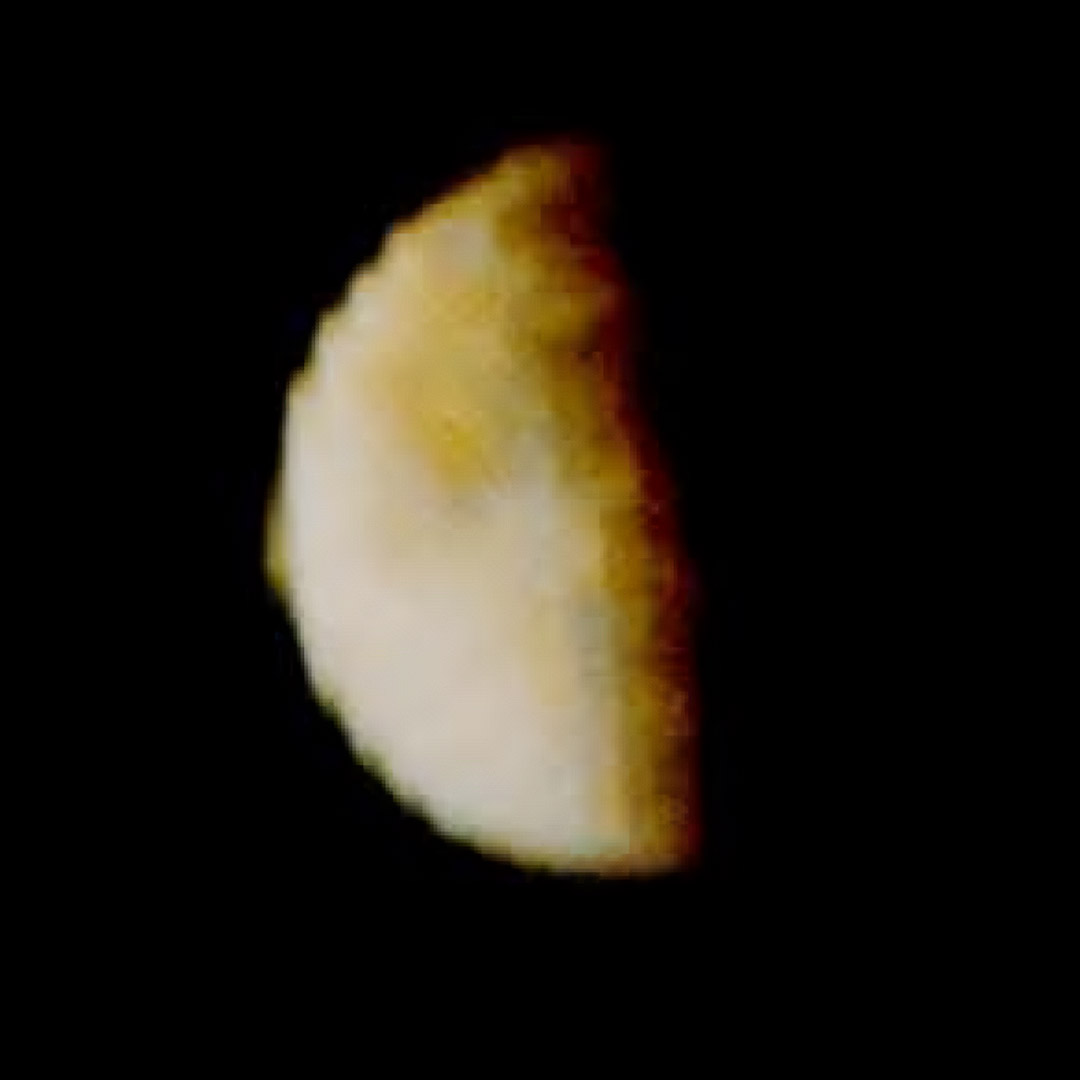
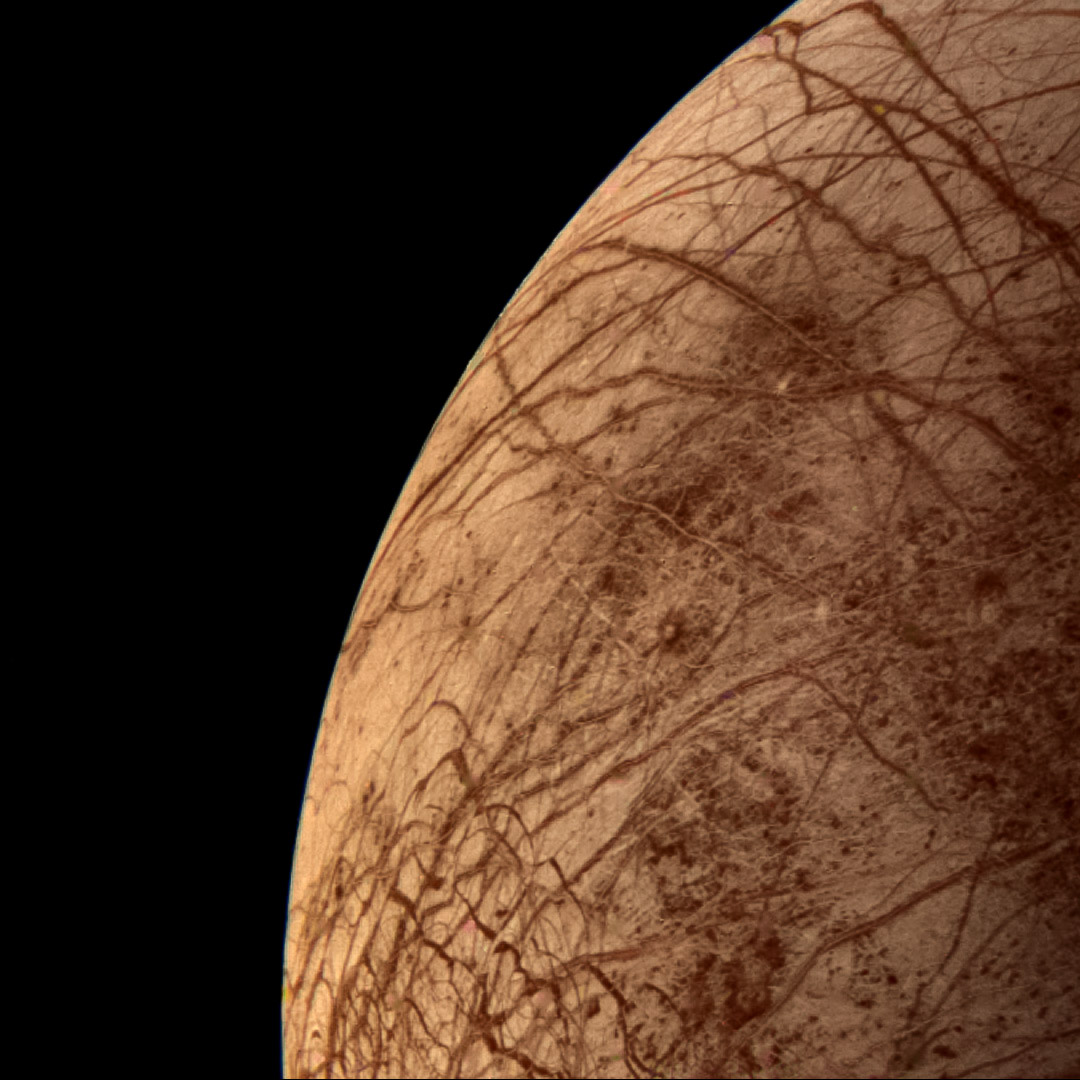
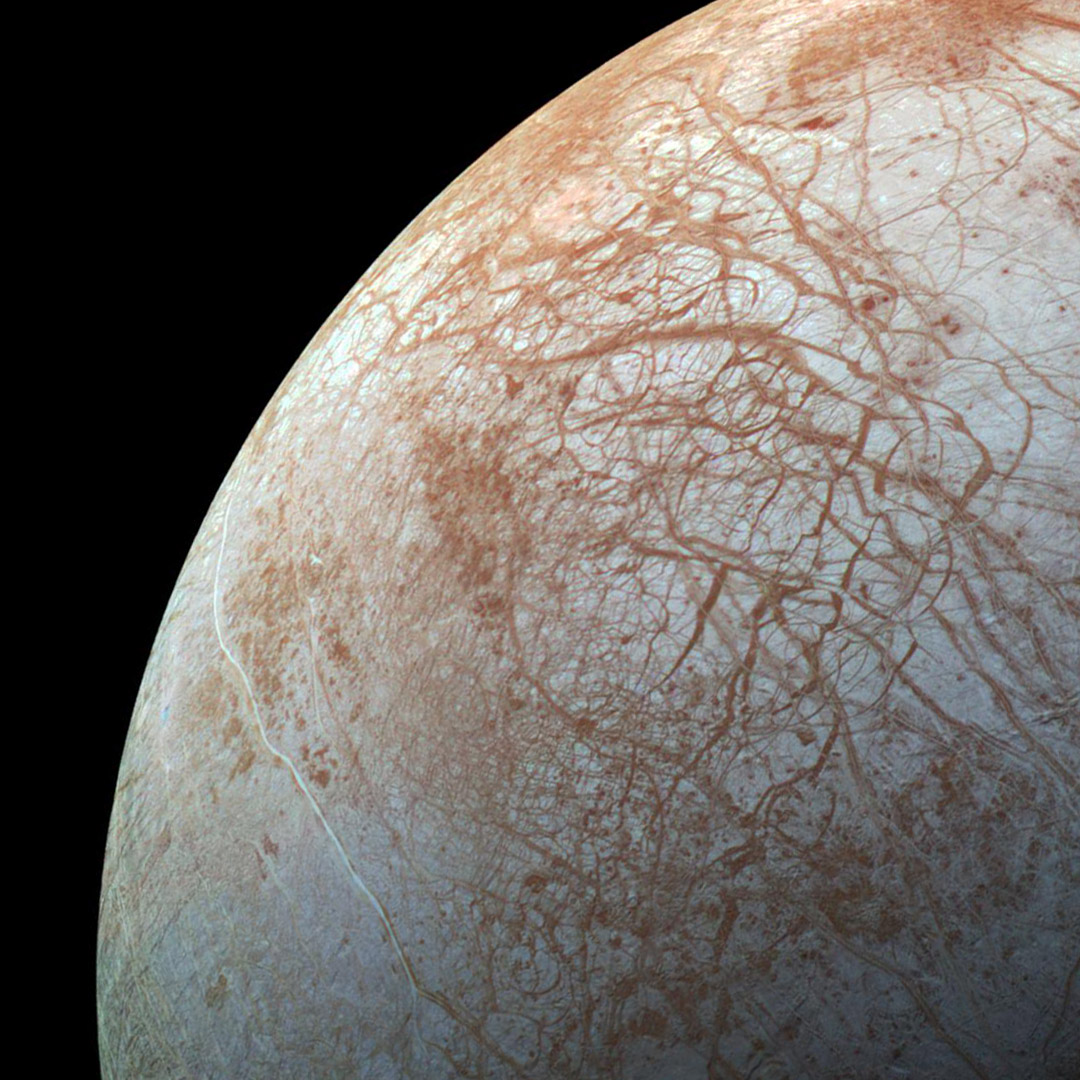
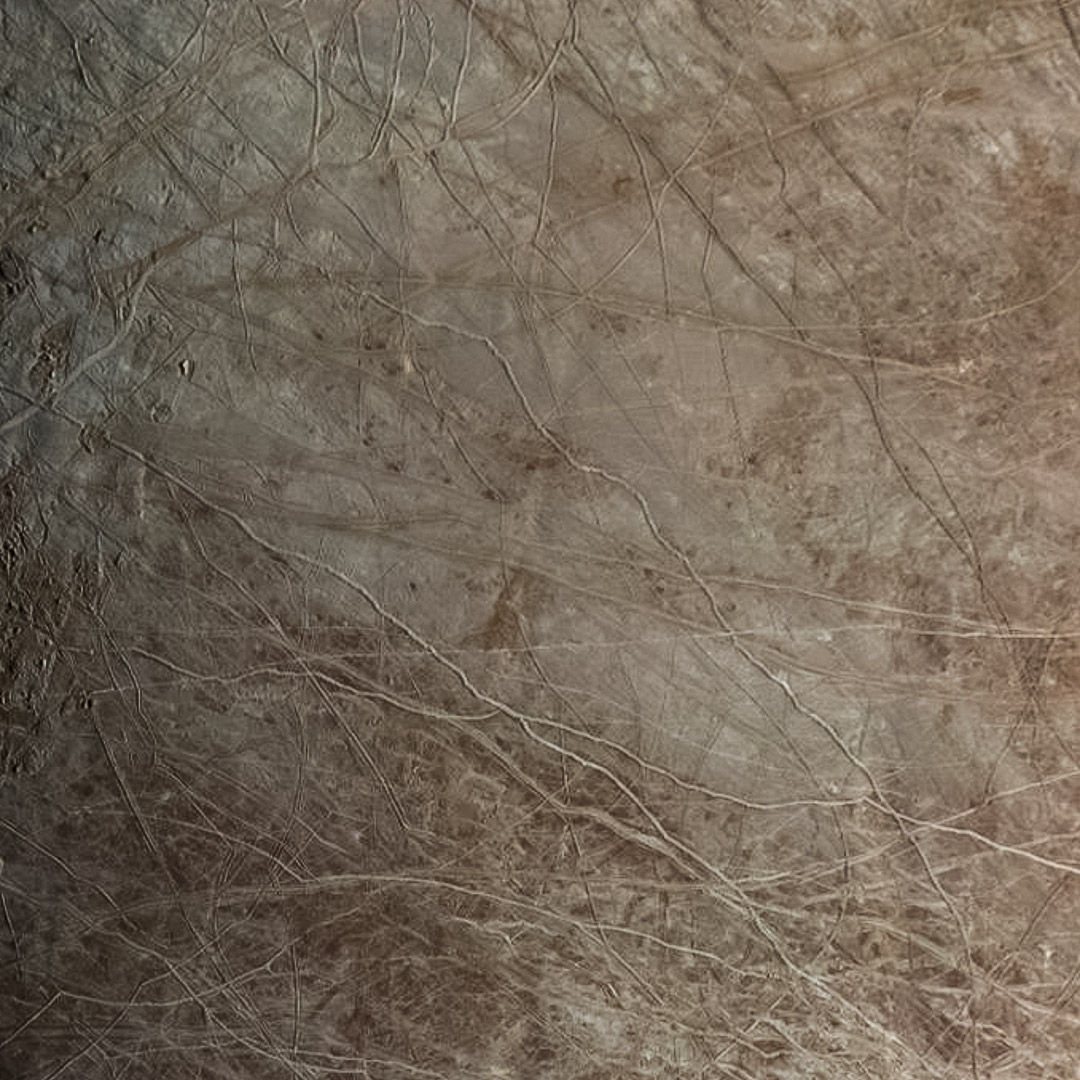
The longer scientists stared at Europa, the more mysteries emerged—like the questions around those ubiquitous dark ridges, often in pairs, that splatter the surface like a Jackson Pollock painting. Theorists have been busy devising explanations. Perhaps they’re made by ice volcanoes or geysers, or cracks where liquid water from subsurface pools rose, froze, and crumbled as the opening closed again. Maybe they resulted from subduction, which occurs on Earth in plate tectonics, as one giant sheet of ice slid and crumpled under another. “I’ve lost count of the number of different models for forming those landforms, but we really don’t know how they form,” Prockter says. “Part of the reason is that geology is based on Earth geology, but it’s not like Earth.”
One particularly striking image of Europa, captured in September 2022 by a camera on the Juno spacecraft, which is currently exploring Jupiter, reveals many of the features that are driving scientists to want to take a closer look. It shows the side of Europa that always faces Jupiter, bathed in sunlight. The moon’s surface is covered with cracks, streaks, and ridges where water may rise from the ocean beneath, or where irradiated surface material may sink lower. It also shows the “chaos terrains”—remarkably messy areas suggesting that giant pieces of ice have broken off, moved around, and refrozen, bolstering the case for geological activity similar to plate tectonics on Earth.
However, Juno’s brief two-hour flyby failed to answer questions about how those features formed or to confirm the existence of a buried ocean. For planetary scientists and astrophysicists, Clipper’s data can help fill in the missing knowledge. It will also push our relationship with Europa into new, unexplored territory.
What all those previous missions did do was help build enthusiasm for the plan to get to Europa, a plan that has evolved dramatically over the last 20 years. Originally, scientists wanted orbiters and landers, and NASA and ESA were working together on a joint mission with multiple spacecraft. Those plans fizzled, but in 2013—as a result of the 2011 Decadal Survey, a report that sets the priorities for space exploration for the next 10 years—NASA approved a plan to send an orbiter. By 2015, the agency had selected the instruments on board. Independently, the ESA moved forward with its own mission, with a broader goal of studying Jupiter’s icy moons.
“The Voyager mission transformed Europa from a light in the sky to a geologic world, and then the Galileo mission did the transformation to an ocean world,” says Diana Blaney, a JPL geophysicist who leads the Clipper team charged with using a mapping image spectrometer to identify molecules on Europa’s surface. “Hopefully, Clipper will bring the transformation to a habitable world.”
Getting in close
Researchers have long searched for signs of habitability in the solar system. Landers and rovers on Mars have found evidence of liquid water, mostly long gone, and organic molecules, which contain carbon, often in chains or rings. The building blocks of biological organisms—including nucleic acids and proteins—all contain carbon, which is why scientists get excited when they find organic molecules. Their presence could indicate that it’s possible for the precursors of life to form.
But it’s not enough just to have promising pieces in place. Any alien species would also have to find a way to grow and survive. That far from the sun, photosynthesis is likely impossible. Organisms would necessarily be fueled by chemical energy, much as microbial extremophiles near the black smokers and hydrothermal vents on the seafloor live off the minerals and methane.
The possibility for Europan life is at the mercy of the moon’s geophysics, says Lynnae Quick, a planetary geophysicist at NASA’s Goddard Space Flight Center. In fact, she argues that you can’t have one without the other. Europa seems to host the necessary ingredients for life. But ingredients alone, on Europa as in the kitchen, won’t spontaneously combine in the right way on their own. Other forces have to intervene: the moon needs to shift and squeeze, with heat, to mix the minerals from the seafloor with the salt water and any irradiated particles that seep down from the icy surface. “We need something to stir the pot, and I think the geophysical processes do that,” says Quick, whose graduate work on cryovolcanism in alien worlds led to her recruitment to join Clipper. She’s particularly excited about the possibility of finding pockets of warm salty water, trapped just beneath the surface, that could be abodes for life.
“Europa is my favorite body in the solar system,” Quick confesses. But she notes that other ocean worlds also offer promising places to look for signs of life. Those include Enceladus, a small moon of Saturn that, like Europa, has an icy crust with an ocean beneath. Images from the Cassini mission in 2005 revealed that geysers on the south pole of Enceladus spew water and organic molecules into space, feeding Saturn’s outermost ring.
However, Europa is bigger than Enceladus and is more likely to have a surface covered in icy plates that move in a way similar to Earth’s plate tectonics. This sort of activity would help combine the ingredients for life. Ganymede, another Jovian moon and the solar system’s largest, also likely has a liquid ocean, but sandwiched between two ice layers; without an interface between water and minerals, life is less probable. Other possible places to look include Titan, Saturn’s biggest moon, which also probably hides a liquid-water ocean beneath an ice crust. (Quick is an investigator on Dragonfly, a mission to explore Titan, scheduled to launch in 2028.)

To look for the signs and signals of habitability, Clipper will use nine primary instruments. These will take pictures of the surface, look for water plumes, use ground-penetrating radar to measure the icy shell and search for the ocean below, and take precise measurements of the magnetic field.
The spacecraft will pass close enough to the moon to sample its thin atmosphere, and it will use mass spectrometry to identify molecules in the gases it finds there. Another instrument will enable scientists to analyze dust from the surface that has been kicked into the atmosphere by meteorite collisions. With any luck, they’ll be able to tell if that dust originated from below—from the enclosed ocean or subsurface lakes trapped in the ice—or from above, as fragments that migrated from the violent volcanoes on the nearby moon Io. Either scenario would be interesting to planetary geologists, but if the molecules were organic and came from below, they would help build the case that life could exist there.
ESA’s Juice mission has a similar suite of instruments, and scientists from the two teams meet regularly to plan for ways to jointly exploit the data when it starts coming in—five or six years from now. “This is really very good for scientists in the planetary community,” says Lorenzo Bruzzone, a telecommunications engineer at the University of Trento who leads the Juice mission’s radar tool team. He’s long been involved in efforts to get to Europa and the rest of the Jovian system.
Because Juice will visit the other ocean-bearing Galilean moons, Bruzzone says, data from that mission can be combined with Clipper’s to generate a more comprehensive picture of the geological processes and potential habitability of all the ocean worlds. “We can analyze the differences in subsurface geology to better understand the evolution of the Jupiter system,” he says. Those differences may help explain, for example, why three of the Galilean moons formed as icy worlds while the fourth, Io, became a volcanic hellscape.
Jupiter’s radiation has the potential to interfere with every measurement, turning a meaningful signal into a mess of digital snow, like static on a television screen.
To make sure those instruments work when they get there, engineers and designers for both missions have had to contend with a raft of challenges. Many of them revolve around energy: Europa receives only a fifth as much sunlight as Earth. Clipper addresses the problem with gargantuan solar panels, which will span 30 meters when fully extended. (An earlier proposal for a mission to Europa included nuclear batteries, but that idea was expensive, and it was ultimately scrapped.)
In addition, Jupiter’s magnetic field is more than 10,000 times more powerful than Earth’s, accelerating already-energetic particles around the planet to create an intense radiation environment. The radiation has the potential to interfere with every measurement—turning a meaningful signal into a mess of digital snow, like static on a television screen—and can threaten the integrity of the instruments.
To slow the accumulation of radiation damage, Clipper won’t orbit Europa when it reaches the moon in 2030; instead, it will make about 50 flybys over four years, swooping nearer and farther from the destructive radiation field. At its closest, it will pass just 16 miles above the surface. The name points back to fast 19th-century sailing vessels, but it also describes the journey. The craft will sail past the world, over and over. In between passes, its distance from Jupiter will give it openings to transmit data back to Earth.
Those first transmissions will have been generations—if not centuries—in the making. Some of the people who laid the groundwork for the mission, decades ago, have already died. Makris, at MIT, says that when scientists were first discussing how to get to Europa, he was told by Ron Greeley, a planetary geologist and NASA advisor who proposed and fiercely advocated for missions to the moon, that space travel spans generations: “He likened it to building a cathedral.” Prockter notes that by the time Clipper’s data comes in, she’ll be in her late 60s. “I will have spent my entire career on Clipper,” Prockter says. Quick, at 39, is one of the youngest members of the science team.
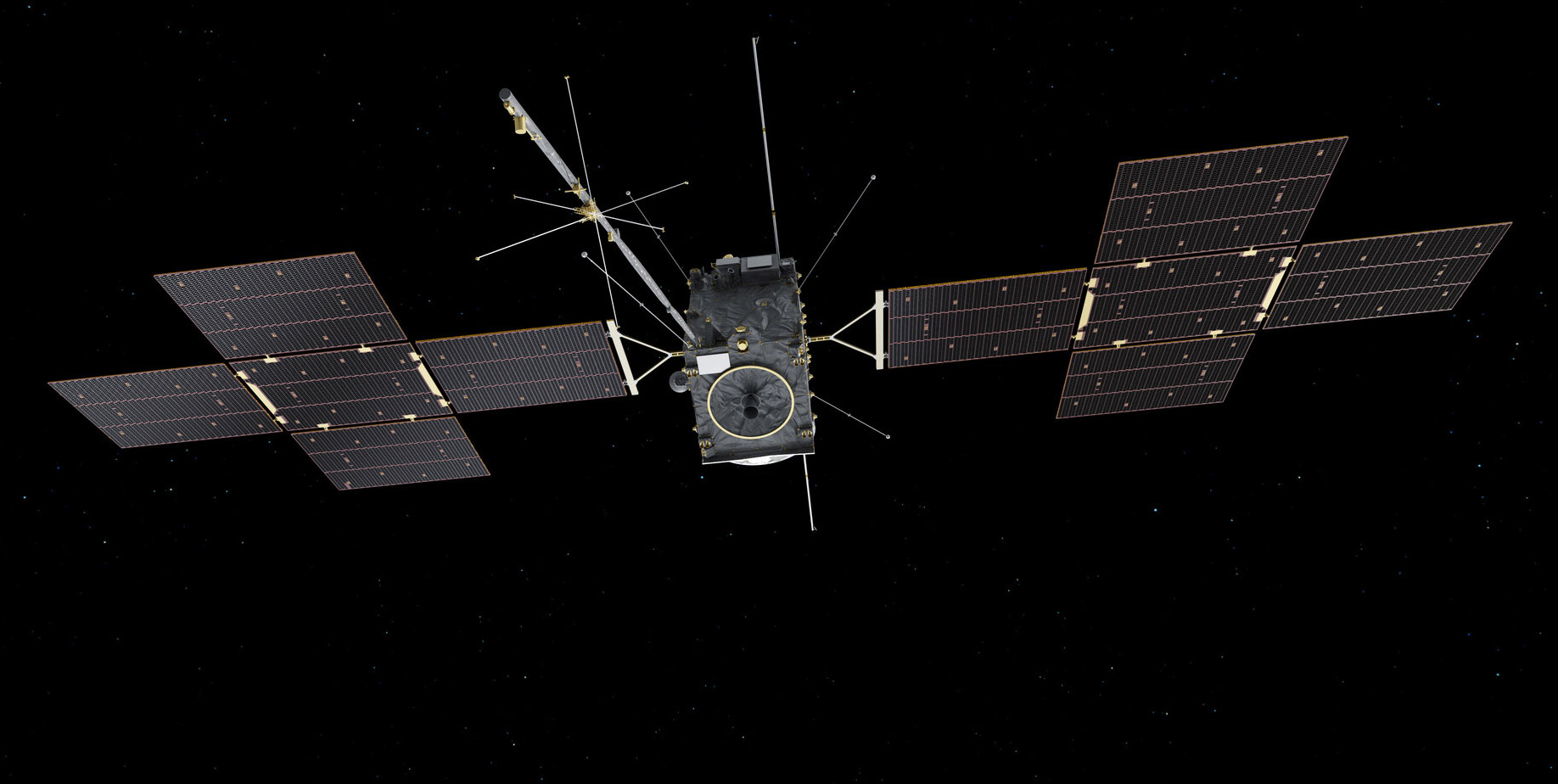
Many of the scientists involved in Clipper—including Pappalardo, Prockter, and Quick—are already planning ways to use its insights for future missions to other worlds. But it’s Europa that holds the most promise, at least for the moment.
Pappalardo thrills at the prospect of finding a Europan neighborhood that might be just right for life. “What if we find a place that’s kind of an oasis, where there are hot spots or warm spots that we detect with a thermal imager?” he says.
Ultimately, Pappalardo says, his hope is that Clipper finds enough evidence to make a strong case for sending a lander someday. The mission’s observations could also tell scientists where to land it: “That would be a place where we’d say, well, we really need to go and scoop up some of that stuff from below the surface, look at it with a microscope, put it in a mass spectrometer, and do the next step, which is to search for life.”
Stephen Ornes is a science writer based in Nashville, Tennessee.
Comments
Post a Comment